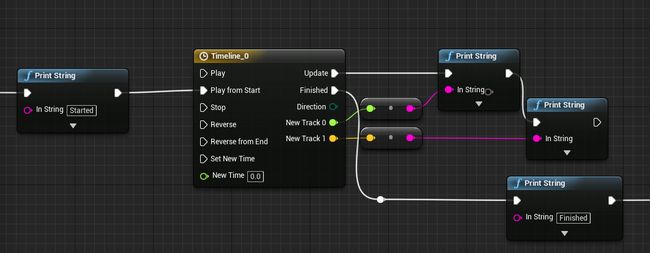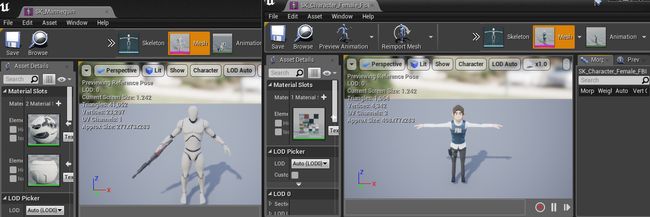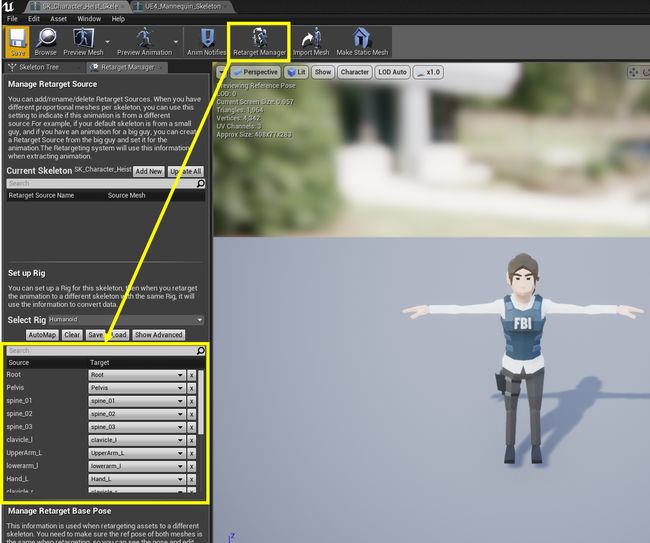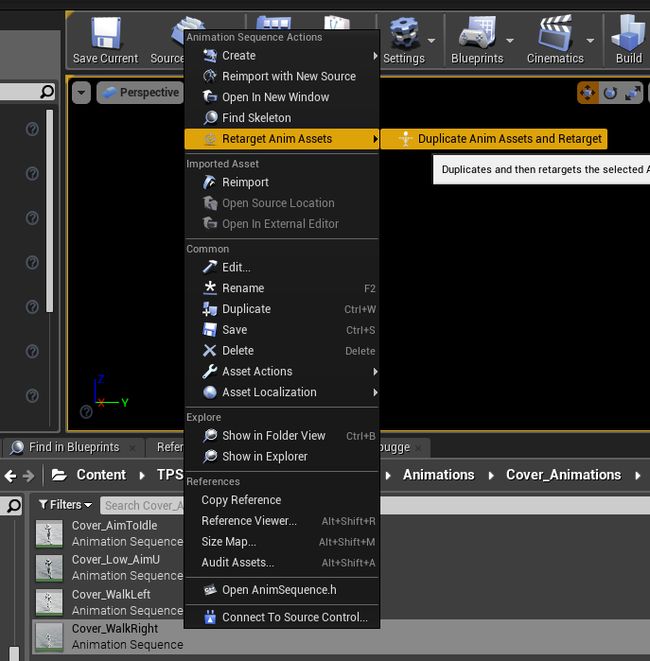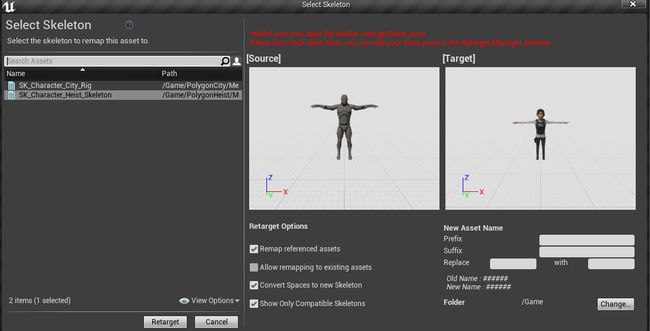1.调试日志UE_LOG和打印输出GEngine->AddOnScreenDebugMessage
蓝图里的PrintString,这里可以用做
if (GEngine)
{
GEngine->AddOnScreenDebugMessage(-1,200,FColor(23,233,4,255), OtherActor->GetName());
}
如果要输出Log,可以用
UE_LOG(LogTemp, Warning, TEXT("Your message"));
参考更多: 如何使用UE_LOG
2.抓取PlayerState, 此处的PlayerState是 AFPSShooterPlayerState
if (GEngine)
{
AFPSShooterPlayerState* curState = Cast(PlayerState);
if (curState)
{
int a = curState->GetGold();
GEngine->AddOnScreenDebugMessage(1, 1,FColor::Red,FString::FromInt(a));
}
}
参考更多: How to access custom PlayerState inside Character
参考更多: 如何配置android的adb环境变量
4.VR模式下镜像显示适配,重点看mode3和mode4
if (WindowMirrorMode == 1)
{// Native mode: single eye
// need to clear when rendering only one eye since the borders won't be touched by the DrawRect below
RHICmdList.ClearColorTexture(BackBuffer, FLinearColor::Black, FIntRect());
RendererModule->DrawRectangle(
RHICmdList,
ViewportWidth / 4, 0,
ViewportWidth / 2, ViewportHeight,
0.1f, 0.2f,
0.3f, 0.6f,
FIntPoint(ViewportWidth, ViewportHeight),
FIntPoint(1, 1),
*VertexShader,
EDRF_Default);
}
else if (WindowMirrorMode == 2)
{// Native mode: stereo
RendererModule->DrawRectangle(
RHICmdList,
0, 0,
ViewportWidth, ViewportHeight,
0.0f, 0.0f,
1.0f, 1.0f,
FIntPoint(ViewportWidth, ViewportHeight),
FIntPoint(1, 1),
*VertexShader,
EDRF_Default);
}
else if (WindowMirrorMode == 3)
{// Self-defined Horizontal
RendererModule->DrawRectangle(
RHICmdList,
0, 0,
ViewportWidth, ViewportHeight,
0.006f, 0.2825f,
0.44f, 0.4425f,
FIntPoint(ViewportWidth, ViewportHeight),
FIntPoint(1, 1),
*VertexShader,
EDRF_Default);
}
else if (WindowMirrorMode == 4)
{// Self-defined Vertical
RendererModule->DrawRectangle(
RHICmdList,
0, 0,
ViewportWidth, ViewportHeight,
0.1f, 0.2f,
0.3f, 0.6f,
FIntPoint(ViewportWidth, ViewportHeight),
FIntPoint(1, 1),
*VertexShader,
EDRF_Default);
}
对应的配置文件修改位置
project folder -> Saved -> Config -> Windows -> Engine.ini
Change:
[SteamVR.Settings]
WindowMirrorMode=0 // 0可以换为1-4的整数
[补全 - 针对 Oculus CV1 和 HTC Vive的优化]
Vive用了以上代码以后,建议在Console里面用命令 “hmd mirror 3” 和 “hmd mirror 4”调用上述代码的修改结果;
Oculus需要使用 “hmd mirror mode 3”和“hmd mirror mode 4”达到某种神奇的效果。
参考更多: UE4 + HTC Vive Fullscreen VR Tutorial
5.用代码实现一次Timeline
官方4.15编辑器,继承Actor Component便于添加到Actor中重用。代码如下,经测试可以使用。
//头文件
#include "Components/ActorComponent.h"
#include "Components/TimelineComponent.h"// for MyTimeline
#include "MyTimelineComp.generated.h"
UCLASS( ClassGroup=(Custom), meta=(BlueprintSpawnableComponent) )
class MYLEARNING415_API UMyTimelineComp : public UActorComponent
{
GENERATED_BODY()
public:
// Sets default values for this component's properties
UMyTimelineComp();
protected:
// Called when the game starts
virtual void BeginPlay() override;
FTimeline* MyTimeline;
UCurveFloat* fCurve;
UCurveVector* vCurve;
/** Update时的float回调的函数变量 */
FOnTimelineFloat MyTimelineFloatFunction;
/** Update时的vector回调的函数变量 */
FOnTimelineVector MyTimelineVectorFunction;
/** Finish时回调的函数变量 */
FOnTimelineEvent MyTimelineFinishedFunc;
/** Update时的float回调的函数 */
UFUNCTION()
void TimelineFloatReturn(float value);
/** Update时的vector回调的函数 */
UFUNCTION()
void TimelineVectorReturn(FVector vector);
/** Finish时回调的函数 */
UFUNCTION()
void TimelineFinished();
public:
/** 启动这个方法 */
void StartTimeline();
// Called every frame
virtual void TickComponent(float DeltaTime, ELevelTick TickType, FActorComponentTickFunction* ThisTickFunction) override;
};
//实现文件,启动方法是 void UMyTimelineComp::StartTimeline()
#include "MyLearning415.h"
#include "Engine.h"
#include "MyTimelineComp.h"
// Sets default values for this component's properties
UMyTimelineComp::UMyTimelineComp()
{
//确保更新方法能运行
//更新方法: void UMyTimelineComp::TickComponent(float DeltaTime, ELevelTick TickType, FActorComponentTickFunction* ThisTickFunction)
PrimaryComponentTick.bCanEverTick = true;
//从Content Browers中获取curve float
static ConstructorHelpers::FObjectFinder CurveFloat(TEXT("CurveFloat'/Game/Misc/FC_Timeline.FC_Timeline'"));
if (CurveFloat.Object) {
fCurve = CurveFloat.Object;
}
//从Content Browers中获取curve vector
static ConstructorHelpers::FObjectFinder CurveVector(TEXT("CurveVector'/Game/Misc/VC_Timeline.VC_Timeline'"));
if (CurveVector.Object) {
vCurve = CurveVector.Object;
}
//构造Timeline,并且设定时间长度
MyTimeline = new FTimeline();
MyTimeline->SetTimelineLength(1.0f);
//绑定Update时的float回调的函数
MyTimelineFloatFunction.BindUFunction(this, "TimelineFloatReturn");
MyTimeline->AddInterpFloat(fCurve, MyTimelineFloatFunction);
//绑定Update时的vector回调的函数
MyTimelineVectorFunction.BindUFunction(this, "TimelineVectorReturn");
MyTimeline->AddInterpVector(vCurve, MyTimelineVectorFunction);
//绑定Finish时回调的函数
MyTimelineFinishedFunc.BindUFunction(this, "TimelineFinished");
MyTimeline->SetTimelineFinishedFunc(MyTimelineFinishedFunc);
}
// Called when the game starts
void UMyTimelineComp::BeginPlay()
{
Super::BeginPlay();
}
void UMyTimelineComp::TimelineFloatReturn(float value)
{// 随Timeline每帧返回float
GEngine->AddOnScreenDebugMessage(-3, 1, FColor::Cyan, FString::SanitizeFloat(value));
}
void UMyTimelineComp::TimelineVectorReturn(FVector vector)
{// 随Timeline每帧返回vector
GEngine->AddOnScreenDebugMessage(-2, 1, FColor::Red, vector.ToString());
}
void UMyTimelineComp::TimelineFinished()
{// Timeline结束的时候调用
GEngine->AddOnScreenDebugMessage(-1, 1, FColor::Green, TEXT("Finished"));
}
void UMyTimelineComp::StartTimeline()
{// 这次我们用的方法是从头播放。
if (MyTimeline != nullptr) {
GEngine->AddOnScreenDebugMessage(-1, 1, FColor::Green, TEXT("Started"));
MyTimeline->PlayFromStart();
}
}
// Called every frame
void UMyTimelineComp::TickComponent(float DeltaTime, ELevelTick TickType, FActorComponentTickFunction* ThisTickFunction)
{
Super::TickComponent(DeltaTime, TickType, ThisTickFunction);
GEngine->AddOnScreenDebugMessage(0, 1, FColor::Yellow, TEXT("Tick"));
if (MyTimeline != nullptr && MyTimeline->IsPlaying())
{//每一帧更新这个Timeline
MyTimeline->TickTimeline(DeltaTime);
}
}
参考文章: [Unreal Engine : Timeline を C++ コードで作成・実行する]
6. 同步玩家的转向
方法一: 使用Pawn.h中的变量RemoteViewPitch同步玩家的Pitch
// pawn.h
/** Replicated so we can see where remote clients are looking. */
UPROPERTY(replicated)
uint8 RemoteViewPitch;
// pawn.cpp
void APawn::SetRemoteViewPitch(float NewRemoteViewPitch)
{
// Compress pitch to 1 byte
NewRemoteViewPitch = FRotator::ClampAxis(NewRemoteViewPitch);
RemoteViewPitch = (uint8)(NewRemoteViewPitch * 255.f/360.f);
}
// MyCharacter.cpp, the implementation
void MyCharacter::Tick(float DeltaTime)
{
Super::Tick(DeltaTime);
if (!IsLocallyControlled())
{
FRotator NewRot = CameraComponent->RelativeRotation;
NewRot.Pitch = RemoteViewPitch * 360.0f / 255.0;
CameraComponent->SetRelativeRotation(NewRot);
}
}
7. 重定向人形动画骨骼
项目中使用的人形骨骼,有可能和Mannequin骨骼不一样;但是,我们从市场上买来人形的动作都是Mannequin骨骼的。下面,简单说下怎么导入Mannequin骨骼(Mannequin骨骼)的动作给项目中使用的骨骼(自定义骨骼)。
-
首先检查“骨骼编辑器”中的Regtarget Manager的设定是否对应正确。这个需要分别检查Mannequin骨骼和自定义骨骼的设定。
-
在“骨骼编辑器”中,调整Mannequin骨骼至T-pose
-
在“骨骼编辑器”中,修改Mannequin骨骼Pose。注:修改后,按下“Hide Pose”按钮,姿势将复原;再次按下就又成了T-pose,请保持姿势为T-pose(其实这个T-pose不太标准)
-
重定向人形动画骨骼,即导入动作。注:可多选
参考视频: [Skeleton Assets: Anim Retargeting Different Skeletons | 03 | v4.8 Tutorial Series | Unreal Engine]
